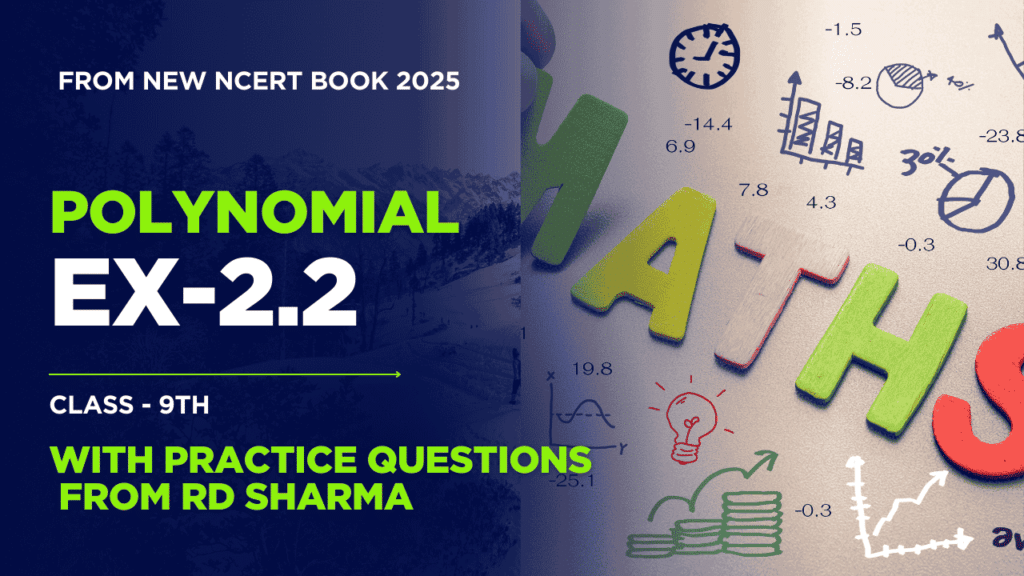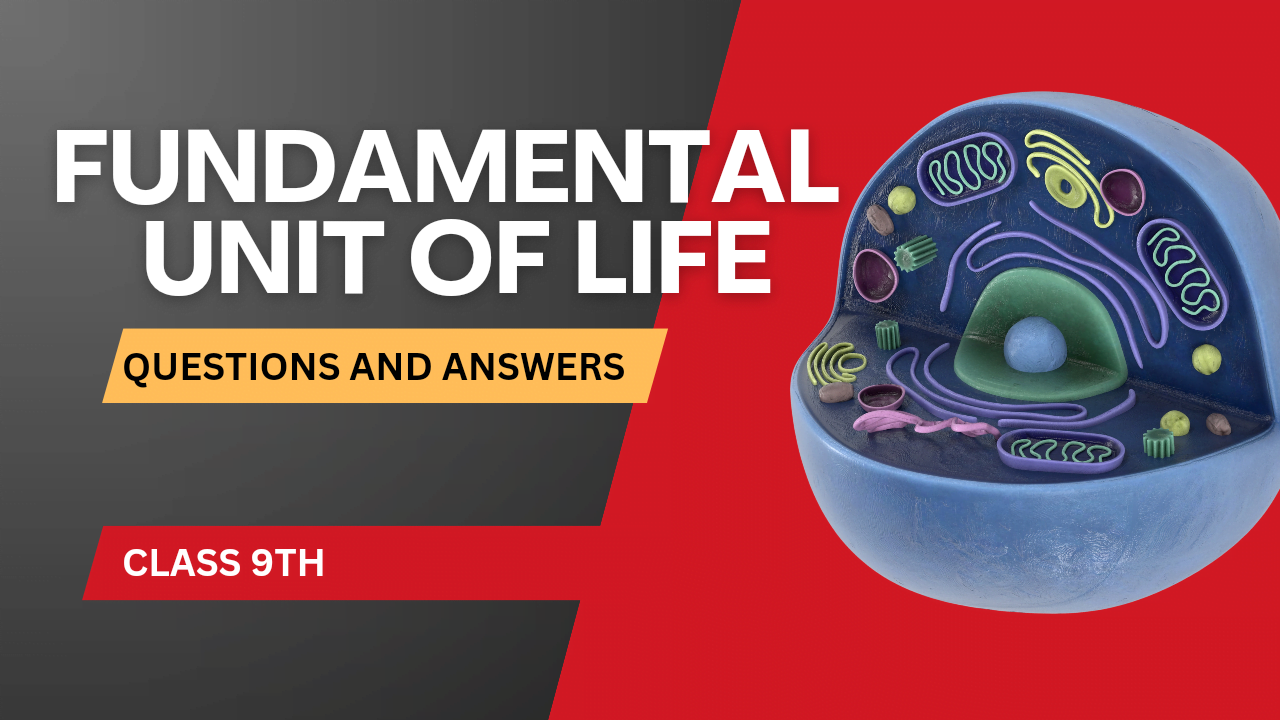
Polynomials Exercise 2.2 Class 9th NCERT Solution (New NCERT BOOK 2025) With Practice Questions From RD sharma
Class 9 Mathematics: Polynomials
Exercise 2.2 Solutions
1. Find the value of \(5x – 4x^2 + 3\) at:
(i) \(x = 0\)
\(5(0) – 4(0)^2 + 3 = 0 – 0 + 3 = \boxed{3}\)
(ii) \(x = -1\)
\(5(-1) – 4(-1)^2 + 3 = -5 – 4 + 3 = \boxed{-6}\)
(iii) \(x = 2\)
\(5(2) – 4(2)^2 + 3 = 10 – 16 + 3 = \boxed{-3}\)
2. Find \(p(0)\), \(p(1)\), and \(p(2)\):
(i) \(p(y) = y^2 – y + 1\)
\(p(0) = 0^2 – 0 + 1 = \boxed{1}\)
\(p(1) = 1^2 – 1 + 1 = \boxed{1}\)
\(p(2) = 2^2 – 2 + 1 = \boxed{3}\)
(ii) \(p(t) = 2 + t + 2t^2 – t^3\)
\(p(0) = 2 + 0 + 0 – 0 = \boxed{2}\)
\(p(1) = 2 + 1 + 2(1)^2 – 1^3 = \boxed{4}\)
\(p(2) = 2 + 2 + 8 – 8 = \boxed{4}\)
(iii) \(p(x) = x^3\)
\(p(0) = \boxed{0}\)
\(p(1) = \boxed{1}\)
\(p(2) = \boxed{8}\)
(iv) \(p(x) = (x – 1)(x + 1)\)
\(p(0) = (-1)(1) = \boxed{-1}\)
\(p(1) = (0)(2) = \boxed{0}\)
\(p(2) = (1)(3) = \boxed{3}\)
3. Verify Zeroes of Polynomials:
(i) \(p(x) = 3x + 1\) at \(x = -\frac{1}{3}\)
\(3\left(-\frac{1}{3}\right) + 1 = -1 + 1 = \boxed{0}\) ✓
(ii) \(p(x) = 5x – \pi\) at \(x = \frac{4}{5}\)
\(5\left(\frac{4}{5}\right) – \pi = 4 – \pi \neq 0\) ✗
(iii) \(p(x) = x^2 – 1\) at \(x = 1, -1\)
\(1^2 – 1 = 0\) ✓, \((-1)^2 – 1 = 0\) ✓
(iv) \(p(x) = (x + 1)(x – 2)\) at \(x = -1, 2\)
\(p(-1) = (0)(-3) = 0\) ✓, \(p(2) = (3)(0) = 0\) ✓
(v) \(p(x) = x^2\) at \(x = 0\)
\(0^2 = 0\) ✓
(vi) \(p(x) = lx + m\) at \(x = -\frac{m}{l}\)
\(l\left(-\frac{m}{l}\right) + m = -m + m = 0\) ✓
(vii) \(p(x) = 3x^2 – 1\) at \(x = \frac{1}{\sqrt{3}}, -\frac{1}{\sqrt{3}}\)
\(3\left(\frac{1}{\sqrt{3}}\right)^2 – 1 = 1 – 1 = 0\) ✓, \(3\left(-\frac{1}{\sqrt{3}}\right)^2 – 1 = 1 – 1 = 0\) ✓
(viii) \(p(x) = 2x + 1\) at \(x = -\frac{1}{2}\)
\(2\left(-\frac{1}{2}\right) + 1 = -1 + 1 = 0\) ✓
4. Find Zeroes of Polynomials:
(i) \(p(x) = x + 5\)
Solve \(x + 5 = 0\) ⇒ \(\boxed{x = -5}\)
(ii) \(p(x) = x – 5\)
Solve \(x – 5 = 0\) ⇒ \(\boxed{x = 5}\)
(iii) \(p(x) = 2x + 5\)
Solve \(2x + 5 = 0\) ⇒ \(\boxed{x = -\frac{5}{2}}\)
(iv) \(p(x) = 3x – 2\)
Solve \(3x – 2 = 0\) ⇒ \(\boxed{x = \frac{2}{3}}\)
(v) \(p(x) = 3x\)
Solve \(3x = 0\) ⇒ \(\boxed{x = 0}\)
(vi) \(p(x) = ax\), \(a \neq 0\)
Solve \(ax = 0\) ⇒ \(\boxed{x = 0}\)
(vii) \(p(x) = cx + d\), \(c \neq 0\)
Solve \(cx + d = 0\) ⇒ \(\boxed{x = -\frac{d}{c}}\)
Additional Practice Questions (RD Sharma)
1. Find \(p(-1)\) for \(p(x) = x^3 – 2x + 5\).
Solution:
\((-1)^3 – 2(-1) + 5 = -1 + 2 + 5 = \boxed{6}\)
2. Verify if \(x = 2\) is a zero of \(p(x) = x^2 – 4x + 4\).
Solution:
\(p(2) = (2)^2 – 4(2) + 4 = 4 – 8 + 4 = 0\) ✓
3. Find the zero of \(p(x) = 4x – 8\).
Solution:
Solve \(4x – 8 = 0\) ⇒ \(\boxed{x = 2}\)
4. Evaluate \(p(3)\) for \(p(x) = x^3 – 3x^2 + 2x – 1\).
Solution:
\(3^3 – 3(3)^2 + 2(3) – 1 = 27 – 27 + 6 – 1 = \boxed{5}\)
5. Find \(p(0)\) for \(p(x) = x^4 – 16\).
Solution:
\(0^4 – 16 = \boxed{-16}\)
6. Verify if \(x = 1\) is a zero of \(p(x) = x^3 – 6x^2 + 11x – 6\).
Solution:
\(1^3 – 6(1)^2 + 11(1) – 6 = 1 – 6 + 11 – 6 = 0\) ✓
7. Find the zero of \(p(x) = 5x + 10\).
Solution:
Solve \(5x + 10 = 0\) ⇒ \(\boxed{x = -2}\)
8. Evaluate \(p(-2)\) for \(p(x) = x^2 + 3x – 4\).
Solution:
\((-2)^2 + 3(-2) – 4 = 4 – 6 – 4 = \boxed{-6}\)
9. Verify if \(x = -3\) is a zero of \(p(x) = x^2 + 5x + 6\).
Solution:
\((-3)^2 + 5(-3) + 6 = 9 – 15 + 6 = 0\) ✓
10. Find the zero of \(p(x) = 7x – 21\).
Solution:
Solve \(7x – 21 = 0\) ⇒ \(\boxed{x = 3}\)



